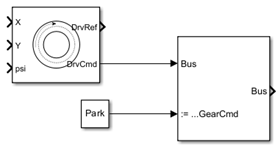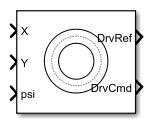Constant Radius
Libraries:
Vehicle Dynamics Blockset /
Vehicle Scenarios /
Drive Cycle and Maneuvers
Description
The Constant Radius block generates an open-loop longitudinal velocity
reference and a reference pose using vehicle feedback to track a constant radius path, which
is helpful to characterize a vehicle’s roll and understeer responses, usually at various
speeds. You can use these references directly with the Predictive Driver
block with the Lateral control type, controlTypeLat parameter set to
Stanley. You can also vary the radius and direction of travel and
optionally stop the simulation at a specified lateral acceleration limit.
Ports
Input
Longitudinal position of the vehicle center of mass in the global coordinate frame, specified as a scalar, in m.
Data Types: double
Lateral position of the vehicle center of mass in the global coordinate frame, specified as a scalar, in m.
Data Types: double
Vehicle yaw angle with respect to the global coordinate system, specified as a scalar, in m.
Data Types: double
Vehicle lateral acceleration needed to stop the simulation, specified as a scalar, in gee.
Dependencies
To enable this parameter, select Stop simulation at lateral acceleration threshold.
Data Types: double
Output
Driver reference data, returned as a bus containing these block values.
| Signal | Description | Units |
|---|---|---|
| Longitudinal reference velocity | m/s |
| Lateral reference displacement | m |
| Vehicle global longitudinal reference position | m |
| Vehicle global lateral reference position | m |
| Vehicle global yaw reference position | rad |
| Reference path curvature | 1/m |
| Reference path curvature gradient | 1/m^2 |
Data Types: bus
Driver command data, returned as a bus containing these block values.
| Signal | Description | Units | |
|---|---|---|---|
|
| Boolean signal used to override driver model steering commands | one |
| Handwheel angle | one | |
| Boolean signal used to override driver model steering commands
with zero when value is | one | |
| Boolean signal used to hold the current driver model steering
output when | one | |
|
| Boolean signal used to override driver model acceleration commands | one |
| Normalized accelerator input | one | |
| Boolean signal used to hold the current driver model acceleration
output when | one | |
| Boolean signal used to override driver model acceleration
commands with zero when value is | one | |
|
| Boolean signal used to override driver model deceleration commands | one |
| Normalized decelerator or brake input | one | |
| Boolean signal used to hold the current driver model deceleration
output when | one | |
| Boolean signal used to override driver model deceleration
commands with zero when value is | one | |
| Normalized handbrake or park brake input | one | |
|
| Command to specify the transmission mode | one |
| Command to specify manual gear number or automatic transmission shifter position | one | |
| Command to upshift | one | |
| Command to downshift | one | |
| Normalized clutch open command for manual transmissions | one | |
Note
By default, the TransCmd bus is not actively used. Use a
Bus Assignment block to override the
TransCmd bus to customize and extend the scenario.

Data Types: bus
Parameters
To edit block parameters interactively, use the Property Inspector. From the Simulink® Toolstrip, on the Simulation tab, in the Prepare gallery, select Property Inspector.
Initial longitudinal start point of the circular reference in global coordinates, in m.
Programmatic Use
To set the block parameter value programmatically, use
the set_param function.
To get the block parameter value
programmatically, use the get_param function.
| Parameter: | X_o |
| Values: | 0 (default) | scalar |
| Data Types: | double |
Initial lateral start point of the circular reference in global coordinates, in m.
Programmatic Use
To set the block parameter value programmatically, use
the set_param function.
To get the block parameter value
programmatically, use the get_param function.
| Parameter: | Y_o |
| Values: | 0 (default) | scalar |
| Data Types: | double |
Starting heading angle of the circular reference in global coordinates, in rad.
Programmatic Use
To set the block parameter value programmatically, use
the set_param function.
To get the block parameter value
programmatically, use the get_param function.
| Parameter: | psi_o |
| Values: | 0 (default) | scalar |
| Data Types: | double |
Radial distance between cones, in m.
Dependencies
To enable this parameter, select Instantiate 3D cones (Simulation 3D Scene Configuration required).
Programmatic Use
To set the block parameter value programmatically, use
the set_param function.
To get the block parameter value
programmatically, use the get_param function.
| Parameter: | radialConeDist |
| Values: | 6 (default) | positive scalar |
| Data Types: | double |
Maximum allowable lateral acceleration before the simulation is stopped, in g.
Dependencies
To enable this parameter, select Stop simulation at lateral acceleration threshold.
Programmatic Use
To set the block parameter value programmatically, use
the set_param function.
To get the block parameter value
programmatically, use the get_param function.
| Parameter: | ayMax |
| Values: | 0.5 (default) | positive scalar |
| Data Types: | double |
Select this parameter to stop the simulation at the lateral acceleration threshold.
Programmatic Use
To set the block parameter value programmatically, use
the set_param function.
To get the block parameter value
programmatically, use the get_param function.
| Parameter: | ayStop |
| Values: | off (default) | on |
| Data Types: | character vector |
Select this parameter to instantiate 3D cones. The Simulation 3D Scene Configuration block is required.
Programmatic Use
To set the block parameter value programmatically, use
the set_param function.
To get the block parameter value
programmatically, use the get_param function.
| Parameter: | use3DCones |
| Values: | off (default) | on |
| Data Types: | character vector |
Extended Capabilities
C/C++ Code Generation
Generate C and C++ code using Simulink® Coder™.
Version History
Introduced in R2024b
See Also
MATLAB Command
You clicked a link that corresponds to this MATLAB command:
Run the command by entering it in the MATLAB Command Window. Web browsers do not support MATLAB commands.
选择网站
选择网站以获取翻译的可用内容,以及查看当地活动和优惠。根据您的位置,我们建议您选择:。
您也可以从以下列表中选择网站:
如何获得最佳网站性能
选择中国网站(中文或英文)以获得最佳网站性能。其他 MathWorks 国家/地区网站并未针对您所在位置的访问进行优化。
美洲
- América Latina (Español)
- Canada (English)
- United States (English)
欧洲
- Belgium (English)
- Denmark (English)
- Deutschland (Deutsch)
- España (Español)
- Finland (English)
- France (Français)
- Ireland (English)
- Italia (Italiano)
- Luxembourg (English)
- Netherlands (English)
- Norway (English)
- Österreich (Deutsch)
- Portugal (English)
- Sweden (English)
- Switzerland
- United Kingdom (English)
